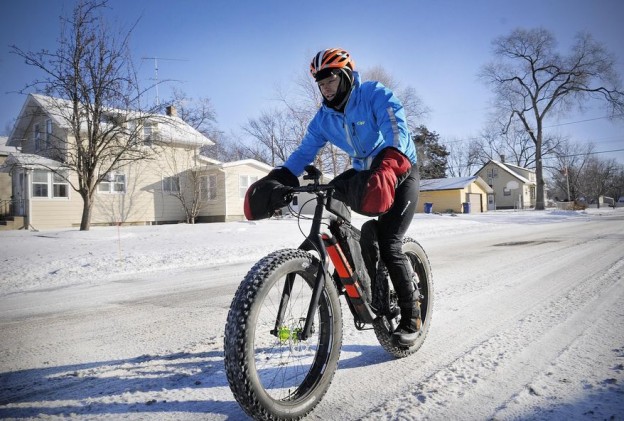[photo above: Ben Doom starts a training ride in St. Cloud, Minn., on Feb. 11, 2015, in preparation for the 350-mile Iditarod Trail Invitational race in Alaska. (AP Photo/The St. Cloud Times, Dave Schwarz)]
Angry moose. Waist-deep snow. Fatigue. River ice overflows.
The Iditarod Trail Invitational, a winter bike and foot race that starts March 1 on Alaska’s famed sled dog trail, is as unpredictable as it is challenging.
“As far as fatbike racing goes, it’s kind of the pinnacle,” said Ben Doom, 39.
To prepare, the first-time ITI competitor from St. Cloud, Minn. fits four-, six- and eight-hour rides between the commitments of work (he co-owns Revolution Cycle & Ski) and family (his three daughters are younger than 12).
“You ride as much as time allows,” Doom said on a recent morning before work. “It’s been tricky this year because of the lack of snow. So I’ve been traveling to try and find snow, because riding on snow offers different resistance.”
To qualify for the 350-mile, off-the-grid route through the Alaskan brush, competitors must have three to five winter endurance race finishes on their resume.
Doom’s includes three Arrowhead 135 finishes. That human-powered race on a snowmobile trail from International Falls to Tower shakes out more than half of its competitors before the finish line. He’s also completed Wisconsin’s 150-mile Tuscobia Winter Ultra and Idaho’s JayP’s Backyard Fat Pursuit.
The ITI application asks about high-altitude mountaineering and Arctic expedition experience.
Finishing is Doom’s goal.
“You’ve had a year to think and stew about it. I’m super excited to do it but until you do a race like this a few times, there’s so many unknowns that I’m never going to be fully prepared for it. So I want to get started, I want to go,” Doom said.
ITI race director Katharina Merchant said finishing should be the goal of all first-timers.
“So many things can go wrong,” Merchant said.
In 2012, for example, a 30-inch snowfall knocked 32 of the 50 competitors out of the race. Eighteen made it to McGrath; no one made it to Nome. But last year, snow was sparse and the trails were hard. About 70 percent of entrants finished.
“The last few years it’s been too easy,” said Merchant, who completed the 350-mile twice and the 1,000-mile once.
This year, poor snow conditions moved the Iditarod sled dog race start 300 miles north to Fairbanks. The ITI will begin, as planned, from a point north of Anchorage. It’ll still cross the Alaska Range — but without the benefit of a trail groomed by snowmobilers preparing for the sled dog race.
The ITI offers a training camp to first-time racers. But its website is skimpy on advice.
The cold could be Doom’s biggest hurdle.
He’s sought advice from other racers. From a Fairbanks source, he received a list of what to do at 20 below, 30 below.
“He ends at 50 below. Fifty below?” Doom said.
Keep moving. Don’t stay in one spot too long.
Doom will heed that advice, plus he’ll keep a sleeping bag, puffy jacket and change of socks handy. He’s consulted some with fellow Minnesotan and fatbike racer Mark Seaburg, 55, a Minneapolis-based physician.
“We both know how to ride our fatbikes in the cold. The problem is going to be to ride them almost three times longer than we have anywhere else,” Seaburg said by phone. “Fingers and toes — if you can keep those warm, you can pretty much do the race.”
Once your hands go numb, however, even simple tasks such as putting on a coat become difficult. Seaburg will use pogies (a sort of mitten that fits on the handlebars), handwarmers, vapor-barrier gloves and mittens.
Doom plans to get more “float” from his Salsa Beargrease Fatbike by switching from 4-inch to 5-inch tires.
Earlier this month, he mailed boxes of gel bars, homemade trail mix, beef jerky and hand warmers to resupply points. He took the ITI’s advice and wrapped everything in duct tape to keep the mice out. In previous years, Merchant said squirrels have gotten into supplies. One year, a wolverine did some damage at a remote drop point.
Doom will box up the bike and fly to Anchorage late this month.
He expects to finish the race in three to five days, but has allowed for up to seven on the trail.
Last year’s 350-mile winner finished in two days, four hours, 43 minutes. Two Minnesotans finished in the top five. In 2012, the winner finished in six days, 15 hours.
“All they worry about is to stay warm and where their next meal is coming from. It’s a simple life,” Merchant said, explaining the appeal and the reason about half of the racers are repeat ITI competitors. “Some people would call it an escape, an escape from reality.”
At some point on the trail when he needs a mental boost, Doom will reach for the iPod loaded with pop, rap and techno tunes.
“In long races, you also have these dark spots where the demons come out and you curse while you’re doing this: Why am I doing this? Why am I here?” Doom said.
“You just want to quit. You want to be home. I know it’s going to happen because this is the longest race I’ve ever done. It’s going to be cold. I’m going to be by myself, in the middle of nowhere. I usually can get through those — I mean I don’t have a choice; I have to get through it. But I’m not looking forward to it, you know.”
The music helps.
“For me, it’s the catchy pop music. You know the words. You can sing along. It’s stupid stuff, but that’s what you want.”
What’s next for Doom?
Finishing would qualify him for the 1,000-mile ITI, which ends in Nome. Thirteen people signed up for the full-distance this year. But Doom said the race is a one-time, bucket-list check-off before he turns 40.
“My plan is to step back a little,” Doom said


